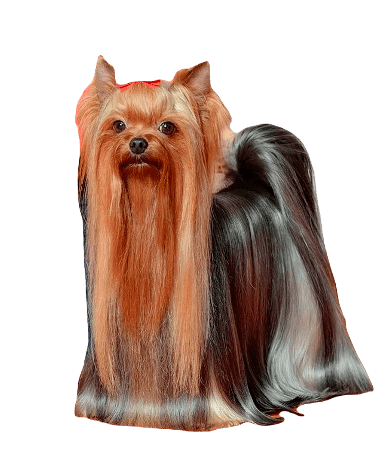Yorkshire terrier dog is smallest of the terrier dog breeds. It was discovered in Yorkshire, England in the 19th century. The Yorkshire Terrier was also a part of the development of other breeds such as the Silky Terrier. The height of the Yorkshire Terrier dog ranges from 8 inches to 9 inches. The lifespan of a Yorkshire Terrier dog is 13 years to 16 years.
A Yorkshire Terrier dog weighs 4 pounds to 7 pounds.
These are very energetic and playful dogs. Yorkshire terrier dogs cannot be alone. For this reason some owners keep another dog along with it. This breed is a cross between two different dogs.
George Year painted a portrait of a Yorkshire terrier also known as Huddersfield Ben. In 1891 Huddersfield Ben became the best stud dog of his breed during his lifetime. The Yorkshire was introduced to North America in 1872 and was the first Yorkshire Terrier registered with the American Kennel Club in 1885.
The Yorkshire Terrier dog became a very popular pet during the Victorian Era in England. The breed’s popularity waned in the 1940s. It participated in World War II and became famous as a war dog. It was the 6th most popular purebred in the United States in 2012 and 2013.

Yorkshire terrier dog has some health problems like bronchitis, cataracts, lymphangiectasia, portosystemic shunt, keratitis sicca, distichiasis, hypoplasia of dens, hydrocephalus, luxating patella, retinal dysplasia and tracheal collapse. It has a sensitive digestive system with diarrhea or vomiting caused by ingestion of food outside of the normal diet.
The Yorkshire Terrier is a toy dog that is prone to injury from other dogs.
Hair loss and swelling at the injection site are more likely to occur as a reaction to the injection. After inection this dog has some allergies, dry skin and itching. So after medical treatment should take care about this dog with proper precautions.
The lifespan of a Yorkshire Terrier dog is 13 years to 20 years.
Small Yorkshires weigh less than 3 pounds or 1.4 kg. A Yorkshire Terrier dog has two sets of teeth like other dog throughout its life. First Teeth 28 Deciduous teeth are also known as baby teeth. The second set of 42 is permanent teeth or adult teeth.
Newborns have no teeth, deciduous teeth grow from 3 to 8 weeks of age. The Yorkshire has no molar teeth. The permanent teeth erupt at 4 months to 8 months of age. Baby teeth should fall out while the permanent teeth are coming in, otherwise it can lead to malocclusion or a bad bite. They are also birth defects that defect Yorkshires.
Distichiasis, where the hair grows from an abnormal part, is common in Yorkshires.
Distichiasis is an eye irritation that causes squint, tearing, burning spots and corneal ulcers. Treatment requires electrolysis or surgery. Dense hypoplasia is the lack of formation of the pivot point of the second cervical vertebra leading to spinal cord damage. It can cause this disease at any age from neck pain to quadriceps.
A portosystemic shunt is a classic malformation of the portal vein. It is also a common disease in the Yorkshires. It can lead to behavioral abnormalities, blindness, coma and sometimes death. A shunt can be treated with surgery.
Hypoglycemia is caused by low blood sugar in puppies.
It is also seen in puppies between 5 and 16 weeks of age. Changes in diet, stress, fatigue, cold weather and lack of proper nutrition can lead to hypoglycemia. It causes apathy, drowsiness, tremors and compulsive feeding. It can permanently damage a dog’s brain and can be fatal in severe cases.
Yorkshire Terrier dog ears are short and V-shaped, and erect. It is customary for a Yorkshire Terrier dog to dock its tail to a medium length.
